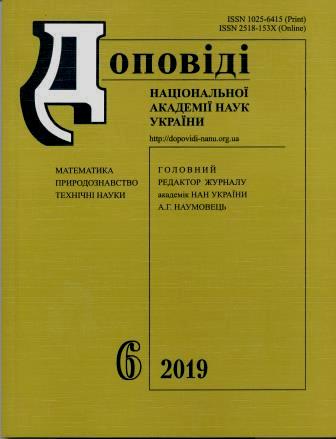п-eлектронна афінність азотистих основ нуклеїнових кислот
DOI:
https://doi.org/10.15407/dopovidi2019.06.075Ключові слова:
π-електронна афінність, кванто- во-хімічні розрахунки, пуринові та піримідинові основи, топологічний індекс ϕ0Анотація
Досліджено відносне розташування фронтальних молекулярних орбіталей азотистих основ нуклеїнових кис лот, пов’язане з їх донорно-акцепторними властивостями як фундаментальною характеристикою спряжених молекул. Для кількісної квантово-хімічної оцінки донорно-акцепторних властивостей пуринових та піримідинових основ запропоновано індекс ϕ0, за яким визначається зсув енергетичних рівнів відносно збалансованої системи. Азотисті основи розділені строго на дві групи: переважно донори — пуринові основи (ϕ0 > 0,5) і переважно акцептори — піримідинові основи (ϕ0 < 0,5). Енергії молекулярних орбіталей оцінені як експериментально, так і квантово-хімічно. Різниця показників ϕ0 — здатність азотистих основ утворювати стабільні π-елекронні комплекси.
Завантаження
Посилання
Saenger, W. (1984). Principles of nucleic acid structure. New York: Springer. doi: https://doi.org/10.1007/978-1-4612-5190-3
Grabowski, S. J. (2001). Hydrogen bonding strength — measures based on geometric and topological parameters. J. Phys. Org. Chem. A., 105, pp. 10739-10746. doi: https://doi.org/10.1002/poc.685
Wesolowski, S. S., Leininger, M. L., Pentchev, P. N. & Schaefer, H. F. (2001). Electron affinities of the DNA and RNA bases. J. Am. Chem. Soc., 123, pp. 4023-4028. doi: https://doi.org/10.1021/ja003814o
Pat. 20120232129 US, Multiantivirus compound, composition and method for treatment of virus diseases, Tkachuk, Z., Publ. 13.09.2012.
Vivcharyk, M. M., Ilchenko, O. O., Levchenko, S. M. & Tkachuk, Z. Yu. (2016). Complexation of RNA with mannitol, its spectral characteristics and biological activity. Dopov. Nac. akad. nauk Ukr., No. 10, pp. 78-83 (in Ukrainian). doi: https://doi.org/10.15407/dopovidi2016.10.078
Shchodryi, V. B., Kachkovskyi, O. D., Slominskyi, Yu. L., Shaudyk, Ye. O. & Tkachuk, Ze. Yu. (2017). Study of the interaction between mannitol and nucleosides using fluorescent probe. Dopov. Nac. akad. nauk Ukr., No. 7, pp. 85-90 (in Ukrainian). doi: https://doi.org/10.15407/dopovidi2017.07.085
Svozil, D., Jungwirth P. & Havlas Z. (2004). Electron binding to nucleic acid bases. Experimental and theoretical studies. review. Collect. Czech. Chem. Commun., 69, pp. 1395-1428. doi: https://doi.org/10.1135/cccc20041395
Obernikhina, N., Kachaeva, M., Shchodryi, V., Prostota, Ya., Kachkovsky, O., Brovarets, V. & Tkachuk, Z. (2019). Topological index of conjugated heterocyclic compounds as their donor/acceptor parame ter. Polycycl. Aromat. Comp., 39, No. 1, pp. 1-14. doi: https://doi.org/10.1080/10406638.2018.1538056
Dewar, M. J. S. (1970). The molecular orbital theory of organic chemistry. New York: McGraw Hill. doi: https://doi.org/10.1002/ange.19700820418
Frisch, M. J., Trucks, G. W., Schlegel, H. B. et al. (2003). GAUSSIAN 03; revision B.05, Gaussian, Inc., Pittsburgh, PA.
Hoffmann R. (1963). An extended hückel theory. I. Hydrocarbons. J. Chem. Phys., 39, pp. 1397-1412. doi: https://doi.org/10.1063/1.1734456
Obenland, S. & Schmidt, W. (1975). Photoelectron spectra of polynuclear aromatics. IV. The Helicenes. J. Am. Chem. Soc., 97, pp. 6633-6638. doi: https://doi.org/10.1021/ja00856a006
Hudson, B. S., Ridyard, N. A. & Diamond, J. (1976). Polyene spectroscopy. Photoelectron spectra of the diphenylpolyenes. J. Am. Chem. Soc., 98, pp. 1126-1129. doi: https://doi.org/10.1021/ja00421a700
Orlov, V. M., Smirnov, A. N. & Varshavsky, Ya. M. (1976). Ionization potentials and electron-donor ability of nucleic acid bases and their analogues. Tetrahedron Lett., 48, pp. 4377-4378. doi: https://doi.org/10.1016/0040-4039(76)80120-7
Chen, E. C. M., Chen, E. S. D. & Sane, N. (1998). The electron affinities of the radicals formed by the loss of an aromatic hydrogen atom from adenine, guanine, cytosine, uracil, and thymine. Biochem. Biophys. Res. Commun., 246, pp. 228-230. doi: https://doi.org/10.1006/bbrc.1998.8584
##submission.downloads##
Опубліковано
Як цитувати
Номер
Розділ
Ліцензія
Авторське право (c) 2024 Доповіді Національної академії наук України

Ця робота ліцензується відповідно до Creative Commons Attribution-NonCommercial 4.0 International License.




